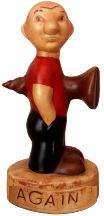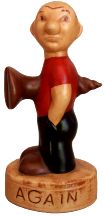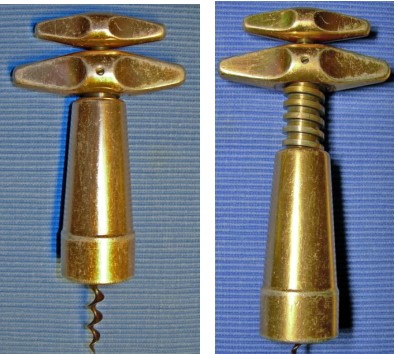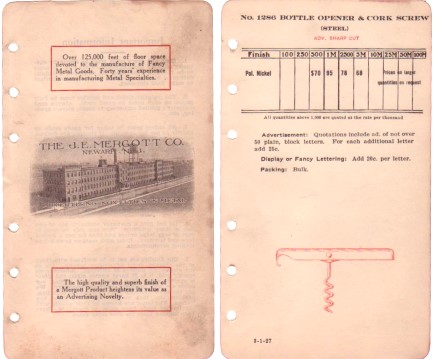 |
 The Virtual Corkscrew Museum's Weekly Newspaper |
 |
 |
 The Virtual Corkscrew Museum's Weekly Newspaper |
 |
|
Sunday, December 16, 2007 |
Number 494 |
The Corkscrew Picket
Corkscrew Mystery Revisited
This appeared in the July 2, 2006 issue:
Elgin, Illinois - Reader Joe Young reports "Have you ever seen a corkscrew picket fence? I haven't, but here is a wood handled Williamson corkscrew with advertising for 'The Cork Screw Picket Makes the best Fence' on one side and 'The Wilson Wire Fence Co. Holly, Mich. - Write for a Catalogue' on the other. I called the Holly, Michigan, library but they had no record of the Wilson Wire Fence Co. Maybe somebody out there in corkscrewland can help with more information.
In the July 16 issue reader Bob Roger responded with:
"A picket is a stake of some type driven into the ground to secure an animal, either by tying him to it or by connecting parallel pickets to form a fence. The former application is common today in the form of a large wire helix with a loop on top, that is screwed into the ground to tie a dog wire to. The second application is also common today in the form of a chain link fence. The vertical components of such a fence are actually long wire helixes that are intertwined and flattened. Perhaps the Wilson Wire Fence Company made or invented one or both of these applications, and called the chain link fence a corkscrew picket fence because the individual pickets are actually helixes."
This month reader Mark Woodard acquired a Wilson Wire Fence corkscrew and his research brought this response:
"A search on Google Books for 'Wilson Wire Fence' returned 3 documents from 1898-1899. Two of them indicate that Wilson Wire Fence of Holly, Michigan was an exhibitor at the 1898 Indiana and Ohio Sate Fairs. It is feasible that the corkscrews could have been given out as advertising premiums at those two events - the timeframe is right."
Then Mark dug a little deeper "Last night I found a big piece of the puzzle. On a hunch, I search Google for any picket fence patents issued to residents of Holly, MI around that time. I only found one, but it is very compelling. A 'Fence Machine' patent # 643,903 was applied for on Sept. 13, 1898 and issued on Feb. 20, 1900 to John Lane of Holly Michigan. The pickets are shown as members V-V in figure 2. By golly, they look like corkscrews!"
"Finally, I did a Google search on 'Fence Weaving Machine' and nearly all of them show the pickets made of wooden slats, woven together with vertical strands of wire. A few show the use of only wire, but woven in a diagonal latticework pattern. Then, I found patent # 518,506 issued April 17, 1894 to John Lane and Cornelius Lane of Holly Michigan. It also shows corkscrew shaped wire pickets."
Mark concluded "John & Cornelius Lane invented the twisted wire helix fence picket, and their fence was manufactured by Wilson Wire Fence Co. of Holly, Michigan. That explains the advertising on the Wilson Wire Fence Company corkscrew."
Editor's note: Mark Woodard is an avid corkscrew collector and researcher. He is currently working on a book about William Painter, the inventor of the bottle opener (and may other things!)
Italian Valezina

Reader Alfredo Baldi has submitted these photos of an Italian version of the Valezina corkscrew. The original double action Valezina corkscrew was produced in Brighton, England by John Bagwell-Purefoy in a factory in Little Preston Street. The corkscrew was named after his daughter Valezina who said, "He called me after the silver washed fritilitey butterfly female version Valezina. At that time there was only one other person of that name, ,the naturalist Frobel's daughter,whom he asked if he could call me after. Since then my niece has the name and possibly now a few other people as well."

The English Valezina
J. E. Mergott Company
Reader Andy Denes wrote: "I recently stumbled across a 1929 salesman's price list for the J. E. Mergott Company, also known as Jemco. It shows their novelty product line of some 41 different products consisted mostly of desk items, but it included several matchbook and matchbox items. It also included the attached page showing their corkscrew. That page is dated 3-1-27, but the little loose-leaf notebook contained other items dated into 1929. I also am attaching the title page and "Important Information" page, which consists of instructions to the salesman."

U. S. Patent 1,701,950 was granted to William C. Hiering of Newark, New Jersey on February 12, 1929 for his "Pocket Corkscrew." The patent was assigned to the J. E. Mergott Co. of Newark that will be manufacturing it. Mergott also makes the JEM Jr. 120 Girl Scout metal box camera, matchbook holders, brass advertising calendars, advertising mirrors, and other advertising novelties.
After detailing his improvements on the pocket corkscrew, Hiering said of other pocket corkscrews: "Other devices of a foldable nature are also known, but all are more or less objectionable for a variety of reasons, such as, incomplete encasement, liability of becoming inadvertently unfolded from the sheath, lack of adequate strength at the joint, inadequacy of handle leverage, weakness for average work to be performed, etc."
The handle of the corkscrew is formed to include a cap lifter which goes over the top of a crown cap and by pushing down on the handle, the cap is removed.
Stamps
Submitted by Alf Erickson - A gift from his friend Herman Seiger
|
©2007 Don Bull, Editor |